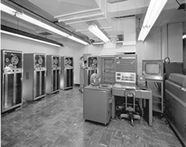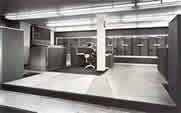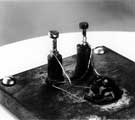 CERN is the European Organization for Nuclear Research, the world’s largest particle physics centre. Here physicists come to explore what matter is made of and what forces hold it together. CERN exists primarily to provide them with the necessary tools. These are accelerators, which accelerate particles to almost the speed of light and detectors to make the particles visible. Founded in 1954, the lab was one of Europe’s first joint ventures and includes 20 Member States.
CERN is the European Organization for Nuclear Research, the world’s largest particle physics centre. Here physicists come to explore what matter is made of and what forces hold it together. CERN exists primarily to provide them with the necessary tools. These are accelerators, which accelerate particles to almost the speed of light and detectors to make the particles visible. Founded in 1954, the lab was one of Europe’s first joint ventures and includes 20 Member States.
Category Archives: 1954
IBM 704
 In 1954 IBM released the next evolution in their 700 series mainframes with the 704. It featured significant improvements over it’s predecessor the 701, including the use of core memory and an expanded instruction set. It wasn’t compatible with it’s older cousin, having a completely new architecture. The 704 was the first mass-produced computer with floating point arithmetic hardware. It did 40k instructions per second and they sold 123 from 1955 to 1960. FORTRAN and LISP were originally developed for the 704. The new instruction set became the basis for the later 700/7000 series systems.
In 1954 IBM released the next evolution in their 700 series mainframes with the 704. It featured significant improvements over it’s predecessor the 701, including the use of core memory and an expanded instruction set. It wasn’t compatible with it’s older cousin, having a completely new architecture. The 704 was the first mass-produced computer with floating point arithmetic hardware. It did 40k instructions per second and they sold 123 from 1955 to 1960. FORTRAN and LISP were originally developed for the 704. The new instruction set became the basis for the later 700/7000 series systems.
NORC (Naval Ordnance Research Calculator)
 The NORC was a vacuum powered computer built by IBM for the U.S. Navy and was delivered in Decemeber, 1954. It was one of the most powerful computers of it’s day, using Williams tubes for memory and had a speed of 15,000 operations per second. It sported a total of 9,800 vacuum tubes and 10,000 crystal diodes.It also had 8 magnetic tape units and two printers. At the presentation ceremony it calculated pi to 3089 digits in a new record time of 13 minutes. In 1955 the system was moved to the Naval Proving Ground in Virginia, where it was used until 1968.
The NORC was a vacuum powered computer built by IBM for the U.S. Navy and was delivered in Decemeber, 1954. It was one of the most powerful computers of it’s day, using Williams tubes for memory and had a speed of 15,000 operations per second. It sported a total of 9,800 vacuum tubes and 10,000 crystal diodes.It also had 8 magnetic tape units and two printers. At the presentation ceremony it calculated pi to 3089 digits in a new record time of 13 minutes. In 1955 the system was moved to the Naval Proving Ground in Virginia, where it was used until 1968.
TRADIC
 TRADIC stands for Transistor Digital Computer, and as the name suggests this was the first machine to use all transistors and diodes and no vacuum tubes. It was built by Bell Labs for the U.S. Air Force, which was interested in the lightweight nature of such a computer for airborne use. The machine consisted of 700 point-contact transistors and 10,000 germanium diodes. During two years of continuous operation only 17 of these devices failed, a vastly lower failure rate than vacuum tube machines of the time.
TRADIC stands for Transistor Digital Computer, and as the name suggests this was the first machine to use all transistors and diodes and no vacuum tubes. It was built by Bell Labs for the U.S. Air Force, which was interested in the lightweight nature of such a computer for airborne use. The machine consisted of 700 point-contact transistors and 10,000 germanium diodes. During two years of continuous operation only 17 of these devices failed, a vastly lower failure rate than vacuum tube machines of the time.
IBM 650
 Excerpt from an IBM press release, 1954 | http://www-1.ibm.com/ibm/history/
Excerpt from an IBM press release, 1954 | http://www-1.ibm.com/ibm/history/
Called the IBM Magnetic Drum Data Processing Machine, it combines one of the advanced memory devices and the stored program concept of IBM’s big “701, recently announced with new high speed reading capacity in the conventional punched card equipment to achieve a powerful data processing machine for commercial and engineering requirements.
In addition to its usefulness as an accounting and computing tool, the Magnetic Drum Data Processing Machine will be a vital factor in familiarizing business and industry with the stored program principles fundamental to electronic data processing equipment. Though its capacity is large, it is designed for exceptional ease of problem preparation and operation. A significant feature of this machine is its ability to check the accuracy of its answers.
Regency TR-1
 Regency Electronics produced the first commercial transistor radio, the Regency TR-1, it hit the consumer market in October, 1954. It featured four germanium transistors operating on a 22.5-volt battery that provided over twenty hours of life (tube radios with batteries only lasted several hours at best-ref). Several colors were initially offered in the 3″ x 5″ x 1 1/4″ plastic case: black, ivory, mandarin red, cloud gray, mahogany and olive green. Radio collectors covet the limited number of units with swirl colors. Fashion iridescent colors were offered later and rare clear plastic cases also were made. The unit weighed eleven ounces and cost $49.95.
Regency Electronics produced the first commercial transistor radio, the Regency TR-1, it hit the consumer market in October, 1954. It featured four germanium transistors operating on a 22.5-volt battery that provided over twenty hours of life (tube radios with batteries only lasted several hours at best-ref). Several colors were initially offered in the 3″ x 5″ x 1 1/4″ plastic case: black, ivory, mandarin red, cloud gray, mahogany and olive green. Radio collectors covet the limited number of units with swirl colors. Fashion iridescent colors were offered later and rare clear plastic cases also were made. The unit weighed eleven ounces and cost $49.95.
Texas Instruments
![]() Newly-christened Texas Instruments, the company becomes the first to produce silicon transistors for the mass market and designs the world’s first transistor radio. Later this decade, Jack Kilby invents the integrated circuit, enabling the digital revolution and forever changing the world.
Newly-christened Texas Instruments, the company becomes the first to produce silicon transistors for the mass market and designs the world’s first transistor radio. Later this decade, Jack Kilby invents the integrated circuit, enabling the digital revolution and forever changing the world.
Junction Transistor
 There was no doubt about it, point-contact transistors were fidgety. The transistors being made by Bell just didn’t work the same way twice, and on top of that, they were noisy. While one lab at Bell was trying to improve those first type-A transistors, William Shockley was working on a whole different design that would eventually get rid of these problems.
There was no doubt about it, point-contact transistors were fidgety. The transistors being made by Bell just didn’t work the same way twice, and on top of that, they were noisy. While one lab at Bell was trying to improve those first type-A transistors, William Shockley was working on a whole different design that would eventually get rid of these problems.
Early in 1948, Shockley conceived of a transistor that looked like a sandwich, with two layers of one type of semiconductor surrounding a second kind. This was a completely different setup which didn’t have the shaky wires that made the point-contact transistors so hard to control.
